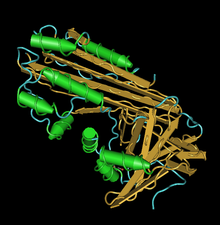Inhibitor of apoptosis
| Cytokine response modifier A | |
|---|---|

crmA structure with visible domain
|
|
| Identifiers | |
| Organism | |
| Symbol | CrmA |
| Alt. symbols | Serine proteinase inhibitor 2 |
| Entrez | 1486086 |
| RefSeq (Prot) | NP_619988.1 |
| UniProt | P07385 |
| Other data | |
| Chromosome | genomic: 0.19 - 0.19 Mb |
Apoptosis, or programmed cell death, is a highly regulated process used by many multicellular organisms. Like any regulated process, apoptosis is subject to either activation or inhibition by a variety of chemical factors. Apoptosis can be triggered through two main pathways; extrinsic and intrinsic. The extrinsic pathway mostly involves extracellular signals triggering intracellular apoptosis mechanisms by binding to receptors in the cell membrane and sending signals from the outside of the cell. Intrinsic pathways involved internal cell signaling primarily through the . Inhibitors of apoptosis are a group of proteins that mainly act on the intrinsic pathway that block programmed cell death, which can frequently lead to cancer or other effects for the cell if mutated or improperly regulated. Many of these inhibitors act to block caspases, a family of cysteine proteases that play an integral role in apoptosis. Some of these inhibitors include the Bcl-2 family, viral inhibitor crmA, and IAP's.
The Bcl-2 family of proteins can either inhibit or promote apoptosis and members are characterized by the Bcl-2 homologous domains BH1, BH2, BH3, and BH4. The combinations of the domains in the proteins determine its role in the apoptosis process. Members of the family that inhibit apoptosis include Bcl-2 itself, Bcl-XL, and Bcl-w, which possess all four of the domains. Bcl-2 is the most well known of the anti-apoptotic members, and is classified as an oncogene. Studies have shown that the Bcl-2 oncogene may inhibit apoptosis in two ways; either by directly controlling the activation of caspases, or by disrupting the channels that allow proapoptotic factors from leaving the mitochondria.
Regarding the activation of caspases, there exists a gene called ced-9 in C. elegans that protects against cell death that is a part of the Bcl-2 family. ced-9 encodes a protein that is structurally similar to Bcl-2 that binds to another protein ced-4, a homolog of APAF-1 in humans, and prevents it from activating caspase ced-3, which is necessary for killing of the cell. In humans APAF-1 actually doesn't interact with Bcl-2; rather it is activated by , the release of which from the mitochondria is regulated by Bcl-2. BAX and BAK are multidomain proapoptoic members of the Bcl-2 family that lie in the cytosol and the mitochondria, respectively. After several stimuli leading to cell death are activated, BAX also moves to the mitochondria where it carries out its functions there. Bcl-2 and Bcl-xl have been found to sequester BH3 domain molecules in the mitochondria, which prevents the activation of BAX and BAK.
...
Wikipedia
